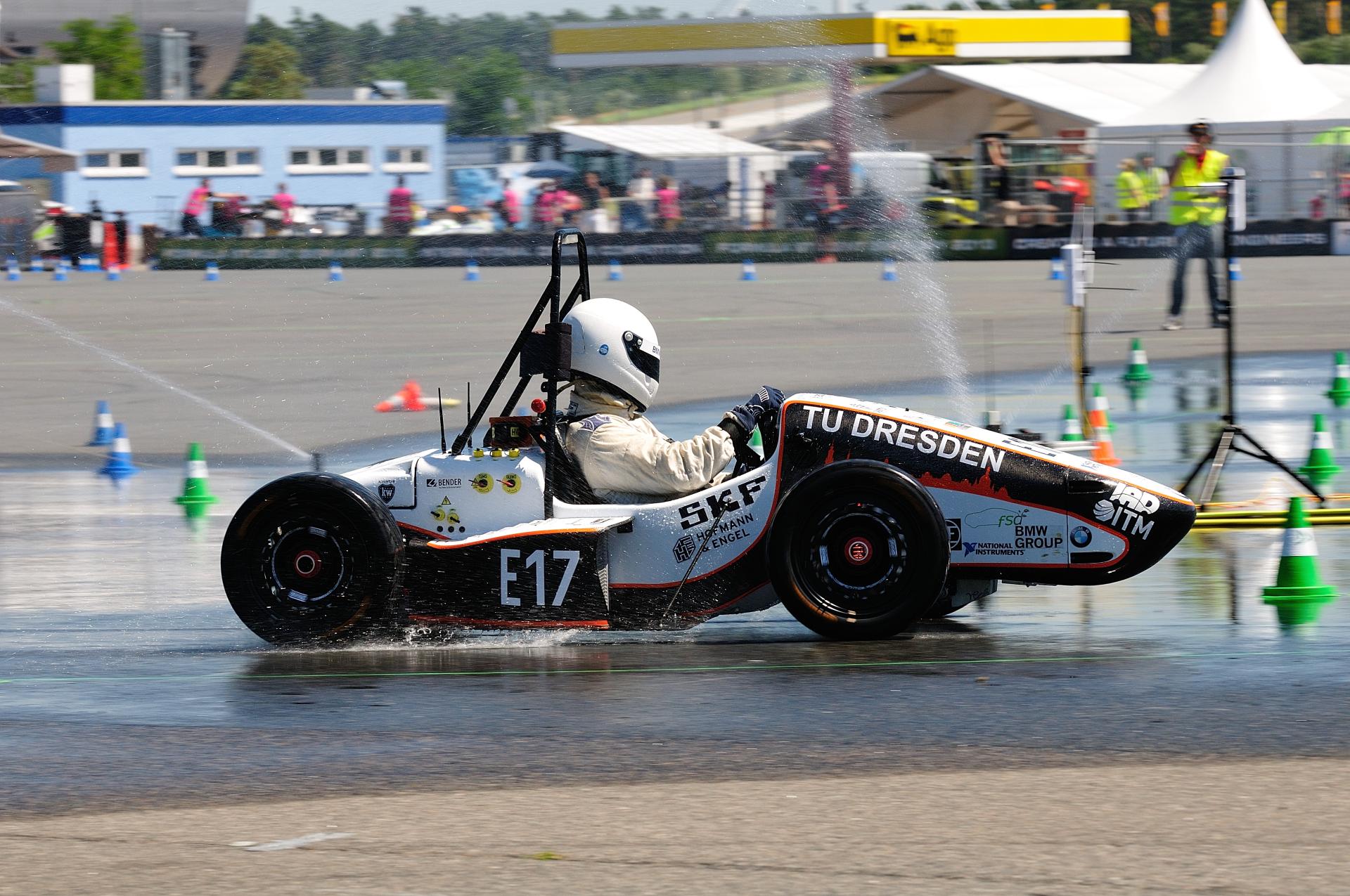KatE


Eckdaten
| Gewicht: | 229,5 kg |
| Leistung: | 2 x 50 kW |
| Spannung: | 600 V |
| Beschleunigung (0-100 km/h): | < 3,0 sek |
| Höchstgeschwindigkeit: | 130 km/h |
Electrical Systems
Das Modul Electrical Systems beschäftigt sich mit allen Komponenten im Fahrzeug, die mit Strom und Spannung zu tun haben. Dazu zählen alle Platinen, der LV- und HV-Kabelstrang, die Programmierung, die Sensoren und der Sicherheitskreis im Fahrzeug. Außerdem wird auch das gesamte Tractive System bestehend aus Akkumulator, Wechselrichtern und Motoren im Modul Electrical Systems bearbeitet. Auch bei den elektrischen Komponenten wurde konsequent auf den Erfahrungen vom Vorjahresfahrzeug Murph-E aufgebaut. Bei der Umsetzung des neuen Fahrzeuges KatE wurde der Fokus sehr stark auf die Komponenten gelegt, die bei Murph-E noch Verbesserungspotential besaßen. Bereits gut funktionierende Komponenten wurden in Richtung erhöhter Effizienz und Zuverlässigkeit weiterentwickelt.
Elektrische Daten zu KatE:
Antrieb:
- 2 permanenterregte Synchronmaschinen Siemens 1FE1064
- Max. Leistung: 50 kW
- Max. Drehmoment: 105 Nm
- Max. Drehzahl: 8000 U/min (elektrisch begrenzt)
- 2 Siemens Wechselrichter SINAMICS S120
- Max. Ausgangsstrom: 141 Aeff
- Max. Ausgangsspannung: 480 VACeff
Akkumulator:
- Max. Akkuspannung: 600 V DC
- Energiegehalt: 5,3 kWh
- 288 Lithium-Polymer-Pouchzellen in 144s2p Verschaltung
- Nennspannung: 3,7 V
- Kapazität: 5 Ah
- Max. Dauerentladestrom: 275 A
- Selbstentwickeltes, umfangreiches Batterie Management System
- DC/DC Konverter zur Versorgung des 24 V Bordnetzes
Sensoren:
- Raddrehzahlsensoren
- Lenkwinkelsensor
- 6-Achs-Sensor
- Federwegsensoren
- Kühlmitteltemperatursensoren
- Bremsscheibentemperatursensoren
- Reifentemperatursensoren
- SmartSensor-Konzept zur direkten Umwandlung der Sensordaten für den CAN-Bus
Weitere Elektronik:
- Single Board Rio von National Instruments
- Fahrzeugsoftware umgesetzt mit LabView
- Rekuperation, Elektrisches Differential, Traction Control, Torque Vectoring
- 2 CAN-Busse zur fahrzeuginternen Kommunikation
- WLAN zur Echtzeittelemetrie-Erfassung
Außerdem ist das Modul für die elektrische Sicherheit verantwortlich. Die Entwicklung und Überwachung von Sicherheitsmaßnahmen ermöglicht allen Teammitgliedern einen gefahrenlosen Umgang mit dem Elektrofahrzeug und seinen Hochvoltkomponenten.
Frame and Body
Das selbsttragende Chassis ist in den vergangenen Jahren zum festen Bestandteil von Elbflorace geworden. Das mittlerweile fünfte Monocoque haben wir im Autoklav-Verfahren mit vorimprägniertem Gelege gefertigt. Dabei stand diese Saison die Verbesserung unseres Lagenaufbaus und der Leichtbaugrad im Mittelpunkt. Wir konnten so erneut ca. 2 kg Masse einsparen. Darüber hinaus war es uns wichtig die Klebefuge durch eine neue Fügemethode zu ersetzen. Neben dem Monocoque haben wir natürlich weitere wichtige Themenbereiche im Modul umgesetzt:
Umsetzung von Aerodynamischen Aspekten
- Intensive Nutzung des Know-Hows der Universität
- Verwendung von Unterböden
- Strömungsoptimierte Auslegung von Nase und Seitenkästen
- Konstruktion des Lenkgetriebecovers zum Ausgleich der Monocoque-Stufen
Gewichtsreduktion
- Unterscheidung in Strukturbauteile und nichttragende Teile
- Optimierung des Crash-Element
- Neues Verfahren für der Firewall-Auflage à Vereinfachung des Fertigungsaufwandes
- Verwendung einer Shoulder Harness Bar
Verbesserung der Ergonomie
- Verstellbare Pedalerie inklusive Fersenführung und seitlicher Abstützung beim Fahren
- Größere Beinfreiheit der Fahrer
- Aufrechtere Sitzposition mit höherer Steifigkeit des Sitzes im Seitenbereich à Stabilität in den Kurven
- Verwendung eines Sitzkissens für kleinere Fahrer
- Verstellbarkeit der Kopfstütze
Erhalt der Wartbarkeit
- Schienensystem für das Battery Case
- Verwendung eines Pedalerie-Mountings
- Übersichtlichkeit und Zugänglichkeit aller Pedalerieteile
- Erhalt des Deckelkonzeptes im Bereich des Motors
Erhöhung der Sicherheit
- LEO-System für Firewall und Battery Case à Brandschutz
- Erhöhung der lokalen Verstärkung des Laminataufbaus im Bereich der Gurtanbindung
Powertrain
Das Modul Powertrain ist dafür zuständig, dass das Potential (die elektrische Energie) in kinetischer Form auf die Straße gebracht wird. Dabei umfasst es die Bereiche Getriebe, Antriebswellen und Kühlung und ist damit Schnittstelle zwischen dem elektrischen Bereich und dem Bereich Aufhängung.
Getriebe
Beim Getriebe wurde auf das bestehende Konzept von Murph-E zurückgegriffen, da die gleichen Rahmenbedingungen sowie Motoren gegeben waren. Bei der Umsetzung wurde darauf geachtet, Fehler aus der vergangenen Saison zu verbessern, was sich vor allem in der Wartbarkeit widerspiegelt. So konnte die Montage im Fahrzeug wesentlich vereinfacht und damit beschleunigt werden. Das Geberrad wurde direkt mit dem Motorzahnrad verbunden, um ein optimales Gebersignal zu erhalten sowie der Zugang zur Motorwelle-Zahnrad-Verbindung verbessert. Auch wurde die Getriebeübersetzung von 4,6 auf 5,8 verändert, um eine bessere Beschleunigung zu ermöglichen. Dies geschah auch unter dem Aspekt der aufgrund der Erhöhung der Spannung verschobenen Feldschwäche um so einen besseren Wirkungsgrad der Motoren zu erzielen. Bei der Konstruktion des Getriebegehäuses wurde das Hauptaugenmerk auf die Vereinfachung der Fertigung gelegt, um möglichst kurze Fertigungszeiten zu ermöglichen und den engen Zeitplan einhalten zu können.
Antriebswellen
Hier wurde ebenfalls das Konzept aus der vergangenen Saison aufgegriffen, jedoch konnte das Gewicht durch die Wahl eines anderes (hochfesten) Stahles noch wesentlich reduziert sowie die Anzahl an Teilen in der Baugruppe verringert werden.
Kühlung
Bei der Kühlung gehen wir diese Saison einen komplett anderen Weg: Zwei statt einem Kühlkreislauf, geringeren Schlauchquerschnitt, stärkere und gleichzeitig kleinere Wasserpumpen, weniger Volumenstrom, modularer Aufbau. Die Kühler sind in dieser Saison vor dem Mainhoop (Überrollbügel) angebracht, um zusammen mit den aerodynamisch ausgelegten Seitenkästen eine möglichst gute Luftdurchströmung und damit Kühlleistung zu ermöglichen. Durch den modularen Aufbau kann der Kühlkreislauf jederzeit verändert werden, um verschiedene Kühlkreislaufkonstellationen zu fahren und zu testen.
Suspension
Das Fahrwerk in KatE orientiert sich größtenteils an Murph-E, was u.a. mit der Verwendung des gleichen Monocoques zusammenhängt. Entsprechend unserem Konzept haben wir an vielen Stellen Fehler und Probleme der letzten Saison behoben, jedoch funktionierende Bauteile nur hinsichtlich Fertigung und Gewicht optimiert. Komplett neu wurden dieses Jahr allerdings die Radhubkinematik gestaltet. So werden die senkrecht stehenden Dämpfer an der Vorderachse über Pull-Rods und an der Hinterachse über Push-Rods angesteuert. Die Konstruktion ermöglicht uns dahingehend ein verlustfreies Einfedern der Rädern und damit eine gute Performance auf der Rennstrecke. Weitere technische Merkmale:
Reifen & Felge
- Continental 205/510 R13
- Braid 6,5×13 Zentralverschluss
Feder/Dämpfer/Stabilisator
- ZF Dämpfer in Verbindung mit H&R Rennsport-Federn
- Schwertstabilisatoren
Bremssystem
- ISR Bremssättel – 4 Kolben vorn, 2 Kolben hinten
- selbst entwickelte Stahlbremsscheiben
- Bremsbalance verstellbar
Lenkung
- Progressives Lenkgetriebe von PSS
- verstellbarer Lenkstockhalter
Querlenker
- Kohlefaser-Rohr mit Aluminium-Inserts
- Injektor-Klebetechnik für hohe Sicherheit
Radträger
- hochfestes Aluminium
- 5-Achs-Fräskonstruktion, topologieoptimiert
- Sturzeinstellung über Verzahnung
